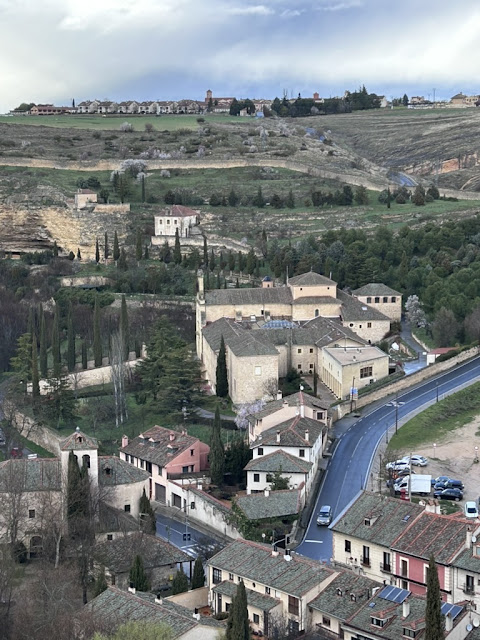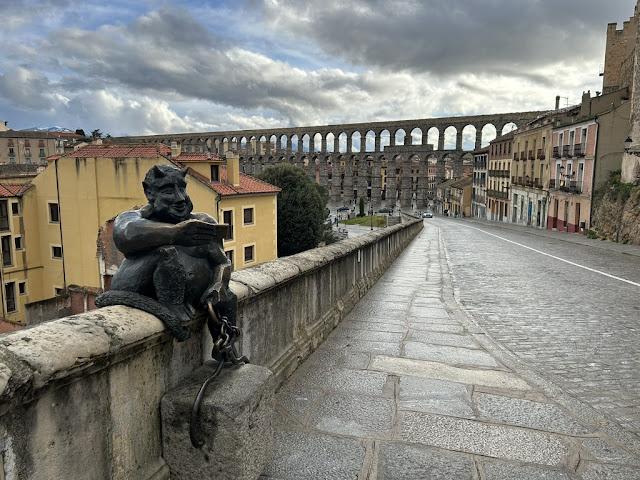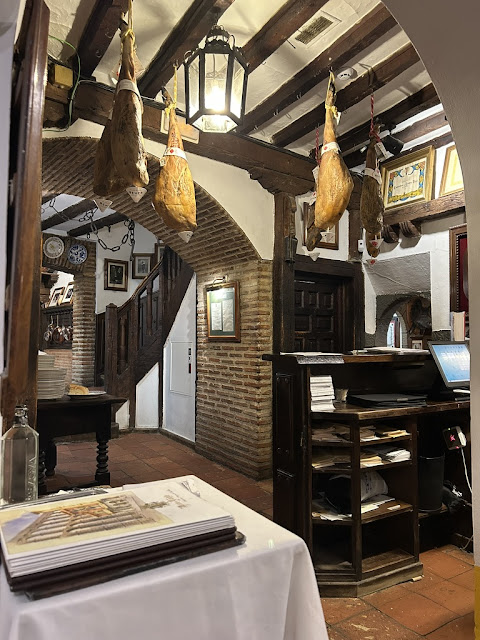Feelings of the Day: This afternoon we went to Segovia, famous for its intact Roman aqueduct, medieval castle, and cochinillo (roast suckling pig). I have found that history is not as fulfilling without experiencing the echoes of culture that created it. In all the places I have traveled, I abide by an important rule: eat where the locals eat and go where the locals go. They know what is good for them and the area. They know what works. It does not matter that the history I see is millennia, centuries, or decades in the past. Some of what you try from the current culture has deep roots. Be brave.
Full Days Events: After an hour or so on the road, we saw the medieval city of Segovia. My wife and I wanted to come here, two years ago, when we were in Spain but could not fit it into our schedule. We were so glad R&J wanted to come back again.
The city of 51k is the capital of the province of Segovia and a UNESCO World heritage site. It has the typical history of communities in Spain: Arevaci Celts -> Romans -> possible Berber/Mozarab/Moor takeover/resettlement -> siege and takeover (with probable retaking and loosing by Berber/Mozarab/Moor) from the small Christian kingdoms or King Ferdinand and Queen Isabella. Therefore, lots of mixed history.
From our Eurostars hotel, a highly recommended place to stay, the dominant feature outside was the city's famous Roman aqueduct. Built in the 1st century CE it brought water, at a 1 percent drop, into the city from 17 km away until 1973. The size and quality of construction is jaw dropping and is one of the best preserved in the world. I do have to be honest though…it isn’t all the same as it was around 1900 years ago. 36 arches were destroyed during a Moor siege in 1072, but was rebuilt by Don Pedro Mesa in the 1400’s CE with financing from King Ferdinand and Queen Isabella. Some call it the Dark ages for lack of science and technology. Bah.
Since we only had one night here, we separated. Natalie and I walked West, on the streets of the South side of the city, to the Alcazar. Moving through several blocks of tourist shops, cheeky stalls, and sub-par eateries it gave way to the heart and soul of old Segovia. Here in the middle and Western end it is still inhabited by families and those who grew up here. Eventually the spaces between the architecture opened up. We had arrived at the Alcazar.
In its current form, the Alcazar of Segovia has been here since the 1100’s and is also a UNESCO world heritage site because of its preservation and history. A Roman fort was originally here but little of it remains after the castle was built by the Berbers. Taken over by King Alfonso the sixth it remained a Castilian royal palace and fortified position for the royal family. Turned over to the Ministry of War, for use as a military college, 125 years ago today it is a favoured tourist destination.
After we approached the front gate I was very focused on getting in. I asked the guard “billetto” (ticket) and the attendant pointed to a building back the way I had come from, off to the side. Turning, I walked in that direction and suddenly noticed the incredible height I was at! I was standing on the castle’s drawbridge! I had a moment of panic, as the chains on either side were too low for my adrenaline infused fear, but I placed my palm beside my eyes like a horse blinder and stared straight ahead to proceed across. If you cannot see it it cannot hurt you, right?
Once we had our tickets, and put my horse blinders on again, we were in the Alcazar. The walls were the same calming yellow cream colour as the outside with huge rooms for use by the royal family and their staff. It has great gathering halls for courtiers and nobles, throne room, small church, bedroom, barracks, courtyard, etc. The views from the base of the main tower on the roof were incredible, but I stayed away from the edge. Natalie was in her element for adventure by getting up close to the deep depths for pictures of the ground below.
While walking back to our hotel we met with R&J, walked on the short stretch of the city walls on the North side of the city, and met a little devil. According to an old folklore tale a little girl who was tired of bringing up water from a well said to a devil that she would trade her soul for an aqueduct if it could be built the following morning when the rooster crowed. The devil didn’t quite make it but still finished. Someone made this statue of a devil taking a selfie with the aqueduct in the background.
After our meal we hung around the aqueduct for a little stroll. Once our supper was digested we retired for the night. 11.6km walked and the equivalent of 37 flights of stairs climbed.
























No comments:
Post a Comment